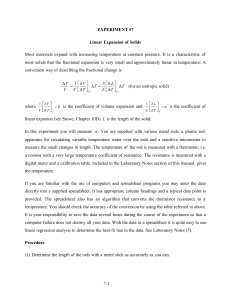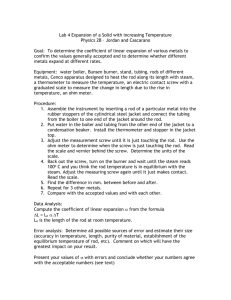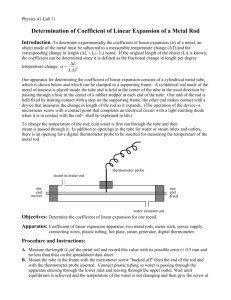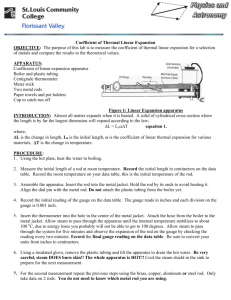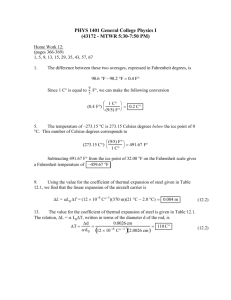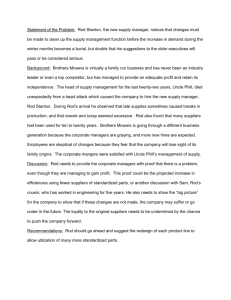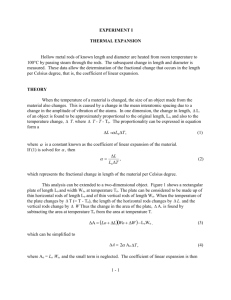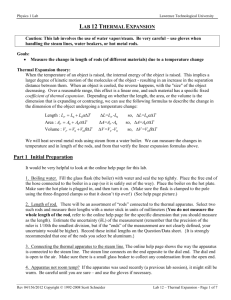Physics 213 Laboratory Coefficient of Linear Expansion
advertisement
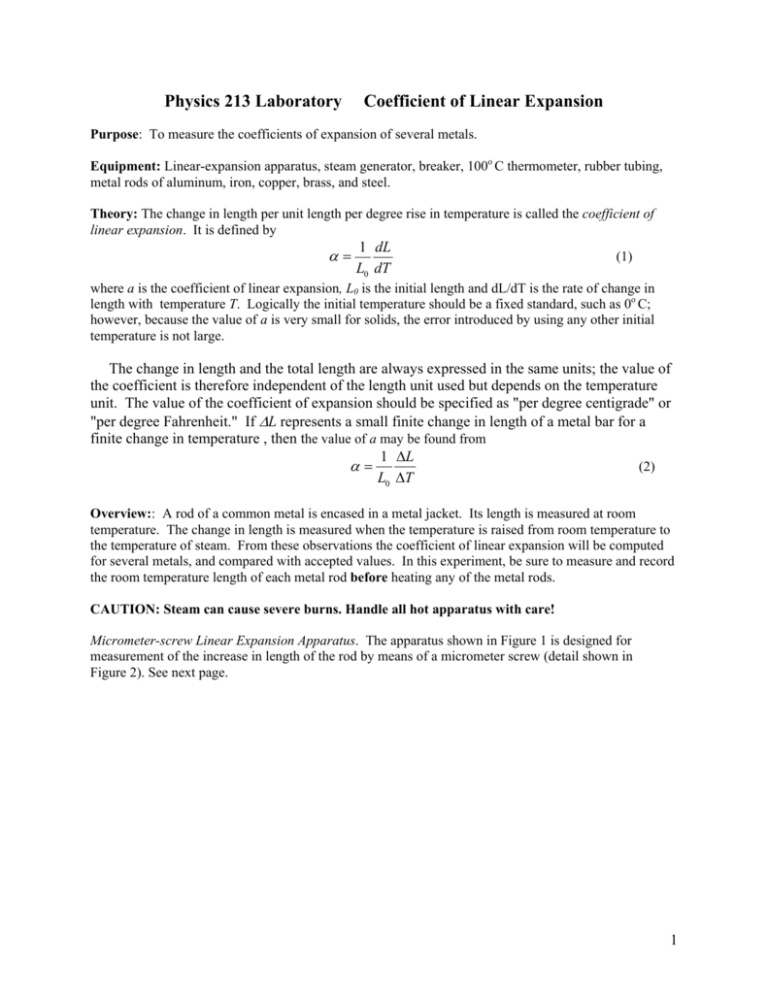
Physics 213 Laboratory Coefficient of Linear Expansion Purpose: To measure the coefficients of expansion of several metals. Equipment: Linear-expansion apparatus, steam generator, breaker, 100o C thermometer, rubber tubing, metal rods of aluminum, iron, copper, brass, and steel. Theory: The change in length per unit length per degree rise in temperature is called the coefficient of linear expansion. It is defined by α= 1 dL L0 dT (1) where a is the coefficient of linear expansion, L0 is the initial length and dL/dT is the rate of change in length with temperature T. Logically the initial temperature should be a fixed standard, such as 0o C; however, because the value of a is very small for solids, the error introduced by using any other initial temperature is not large. The change in length and the total length are always expressed in the same units; the value of the coefficient is therefore independent of the length unit used but depends on the temperature unit. The value of the coefficient of expansion should be specified as "per degree centigrade" or "per degree Fahrenheit." If ∆L represents a small finite change in length of a metal bar for a finite change in temperature , then the value of a may be found from 1 ∆L α= (2) L0 ∆T Overview:: A rod of a common metal is encased in a metal jacket. Its length is measured at room temperature. The change in length is measured when the temperature is raised from room temperature to the temperature of steam. From these observations the coefficient of linear expansion will be computed for several metals, and compared with accepted values. In this experiment, be sure to measure and record the room temperature length of each metal rod before heating any of the metal rods. CAUTION: Steam can cause severe burns. Handle all hot apparatus with care! Micrometer-screw Linear Expansion Apparatus. The apparatus shown in Figure 1 is designed for measurement of the increase in length of the rod by means of a micrometer screw (detail shown in Figure 2). See next page. 1 Figure 1 The linear expansion apparatus. The rods are placed inside the silver jacket and the whole assembly is placed o the black base. Figure 2 Close-up of the micrometer screw at one end of the apparatus. The brass barrel is marked in cm (stamped numbers) with tick marks every mm. the dial allows measurement of 0.01 mm with index being the horizontal line marked on the brass barrel. Procedure: 1). Fill the steam generator two-thirds full of water and turn it on. 2). Insert a rod into the jacket, place it on the base and adjust the micrometer screw until it touches the rod (and the other end of the rod touches the fixed screw). Read the length of the rod using the micrometer scale. Record the length of the rod, the material the rod is composed of, and the room temperature. Repeat this procedure for each rod before heating up any of the rods. 3). Insert a rod in the jacket and place the jacket in the base. Connect the tubing from the steam generator to the expansion apparatus. Lead the tubing from expansion apparatus into a beaker well below the level of the apparatus. 4). Place the thermometer in the opening provided in the expansion apparatus. Allow steam to flow through the jacket until a steady temperature is reached. 5). Turn the micrometer screw until it is snug. Record the readings of the micrometer screw and the thermometer. Turn off the water and drain the jacket. Turn back the micrometer screw at least two full turns. 6). Replace the rod with one made from a different metal by using the new rod to push the old rod out of the jacket. Repeat steps 3 through 5. 7) Repeat steps 3 through 6 for all rest of the rods. 8). Disconnect the apparatus, empty the steam generator and beaker, mop up the water, and leave everything in neat shape. Calculations: 1). From the difference in micrometer-screw readings, or the difference in scale readings, determine the change in length of each rod. 2). From the initial and final temperatures, record the temperature difference. 3). Calculate the coefficient of linear expansion by the use of Eq. (3). 4) Compare this value with a standard value, taken over about the same temperature range. Compute the percent difference between the two, and discuss errors and sources of errors. 2
